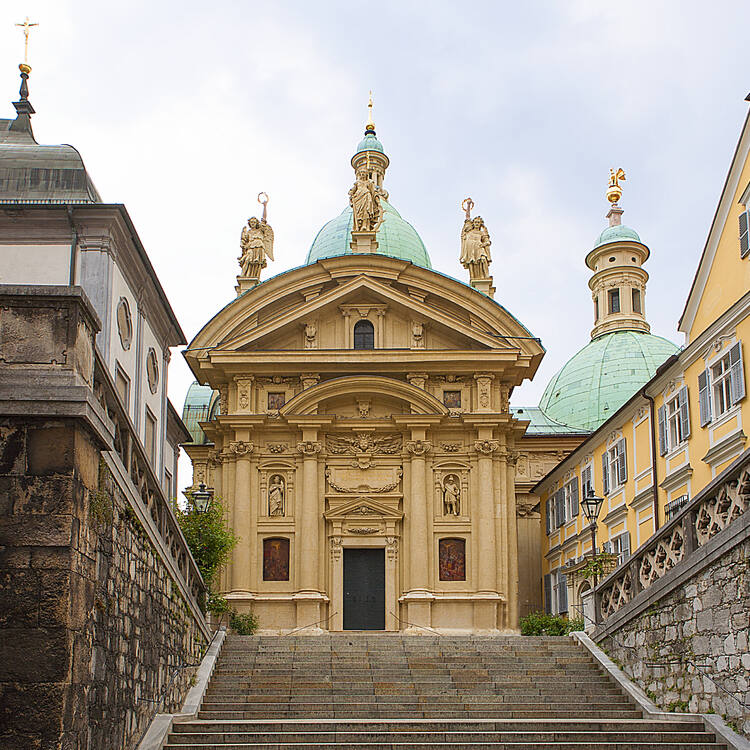City of Graz – Historic Centre and Schloss Eggenberg
City of Graz – Historic Centre and Schloss Eggenberg
The City of Graz – Historic Centre and Schloss Eggenberg bear witness to an exemplary model of the living heritage of a central European urban complex influenced by the secular presence of the Habsburgs and the cultural and artistic role played by the main aristocratic families. They are a harmonious blend of the architectural styles and artistic movements that have succeeded each other from the Middle Ages until the 18th century, from the many neighbouring regions of Central and Mediterranean Europe. They embody a diversified and highly comprehensive ensemble of architectural, decorative and landscape examples of these interchanges of influence.
Description is available under license CC-BY-SA IGO 3.0
Ville de Graz – Centre historique et château d’Eggenberg
La Ville de Graz – Centre historique et le château d’Eggenberg témoignent (ou : La Ville de Graz – Centre historique, château d’Eggenberg témoigne) d’un modèle exemplaire de patrimoine vivant au sein d’un ensemble urbain historique d’Europe centrale, marqué par la présence séculaire des Habsbourg et le rôle culturel et artistique joué par les grandes familles aristocratiques. Ils intègrent harmonieusement les styles architecturaux et les courants artistiques qui s’y sont succédés, depuis le Moyen-Âge jusqu’au XVIIIe siècle, en provenance des nombreuses régions voisines de l’Europe centrale et méditerranéenne. Ils offrent un ensemble diversifié et très complet d’exemples architecturaux, décoratifs et paysagers de ces rencontres d’influences.
Description is available under license CC-BY-SA IGO 3.0
مدينة غراتس ـ المركز التاريخي وقصر إغّنبرج
تُعتبر مدينة غراتس نموذجاً مثالياً حيّاً لمجموعة حضرية في أوروبا الوسطى تتميز بالتاريخ العريق لأسرة هابسبورج. وقد أُدرج الموقع في قائمة التراث العالمي في عام 1999. وتشمل عمليات التوسيع قصر إغّنبورج، الذي يقع على بُعد قرابة ثلاثة كيلومترات غرب المركز التاريخي لمدينة غراتس. وهذا القصرـ الذي شُيّد بعد عام 1625 بقليل ليكون مقراً لإقامة الدوق هانس أولريش فون إغّنبورج (1568ـ 1634)، أحد أبرز رجال السياسة في النمسا أثناء القرن السابع عشرـ يتألف من بناية تمت المحافظة عليها بشكل فائق الجودة، وهي بناية تمثل، بما تتسم به من طراز معماري وزخرفة خارجية، تأثيرات عصر النهضة الإيطالية الآفلة وعصر الباروك.
source: UNESCO/CPE
Description is available under license CC-BY-SA IGO 3.0
格拉茨城历史中心与埃根博格城堡
格拉茨城作为一家展现中欧城市区域的文化遗产单位,格拉茨依然富有活力,堪称文化遗产的典范。格拉茨城于 1999年列入《世界遗产名录》。此次扩展增加了格拉茨城历史中心以西约三公里的埃根博格城堡。1625年,埃根博格城堡在奥地利17世纪最有影响的政治人物汉斯•乌尔里希•冯•埃根博格公爵(1568年至1634年)原有城堡的基础上开始兴建。城堡的建筑保存极其完好,建筑风格和内部装饰体现了意大利文艺复兴时代晚期以及巴洛克时期的影响。
source: UNESCO/CPE
Description is available under license CC-BY-SA IGO 3.0
Город Грац – исторический центр и замок Еггенберг
Грац является воплощением живого наследия, каким является городское поселение Центральной Европы эпохи светского правления Габсбургов. Этот памятник был включен в Список всемирного наследия в 1999 году. Замок Еггенберг, находящийся примерно в 3 км к западу от исторического центра города Грац, стал его расширением. Он был построен приблизительно в 1625 году на месте еще более старого замка в качестве резиденции герцога Ханса-Ульриха фон Еггенберга (1568-1634), одного из самых влиятельных политических деятелей Австрии семнадцатого века. Ныне дворец Еггенберг - это хорошо сохранившееся сооружение, в архитектуре и внешнем оформлении которого нашли отражение поздний итальянский ренессанс и барокко.
source: UNESCO/CPE
Description is available under license CC-BY-SA IGO 3.0
Centro histórico de la ciudad de Graz y palacio de Eggenberg
El centro histórico de Graz es un ejemplo notable de patrimonio cultural viviente. Este complejo urbano de Europa Central lleva la impronta de los muchos siglos en que la ciudad fue gobernada por la dinastía de los Habsburgo. El sitio se inscribió en la Lista del Patrimonio Mundial en 1999 y con la extensión actual comprenderá el palacio de Eggenberg, situado al oeste de la ciudad, a unos tres kilómetros de su centro histórico. Construido después de 1625 para servir de residencia al duque Hans Ulrich von Eggenberg (1568-1634), una de las personalidades políticas más notables del siglo XVIII en Austria, este edificio palaciego se halla en un estado de conservación excepcional. Su arquitectura y ornamentación exterior son buenas muestras de las influencias del arte renacentista italiano tardío y del barroco.
source: UNESCO/CPE
Description is available under license CC-BY-SA IGO 3.0
グラーツ市歴史地区とエッゲンベルグ城
オーストリア南東部、シュタイアーマルク州の州都。オーストリア第2の都市。ムール河畔の比高120mの丘陵に12世紀の城跡があり、その麓に中央広場を囲んで旧市街が発達した。近世にはオスマン・トルコに対する防衛線の要として権力が集中した。16世紀の壮麗なルネサンス様式の宮殿、16世紀創設の大学など歴史的建造物が多く残る。天文学者ケプラーの居住地。後にグラーツ歴史地区の3㎞ほど西にある、17世紀オーストリアの政治家エッゲンベルグ公の城が追加登録された。後期イタリアルネッサンスとバロック時代の影響が見られる。source: NFUAJ
Historisch centrum van Graz en slot Eggenberg
Het historisch centrum van de stad Graz en het slot Eggenberg zijn perfecte voorbeelden van hoe het leven in een centraal-Europees stedelijk gebied is beïnvloed door de eeuwenlange aanwezigheid van de Habsburgers. En ze laten zien dat de belangrijkste adellijke families een grote culturele en artistieke rol hebben gespeeld. Stad en slot zijn een harmonieuze mix van verschillende architecturale stijlen en bewegingen in Midden-en Zuid-Europa, die elkaar opvolgden vanaf de Middeleeuwen tot de 18e eeuw. Het historische centrum en slot Eggenberg vormen een divers en uitgebreid geheel van architectonische, decoratieve en landschappelijke voorbeelden van de eerdergenoemde invloeden .
Source: unesco.nl
Outstanding Universal Value
Brief synthesis
The City of Graz – Historic Centre and Schloss Eggenberg bear witness to an exemplary model of the living heritage of a central European urban complex influenced by the secular presence of the Habsburgs and the cultural and artistic role played by the main aristocratic families. They are a harmonious blend of the architectural styles and artistic movements that have succeeded each other from the Middle Ages until the 18th century, in the many neighbouring regions of Central and Mediterranean Europe. They embody a diversified and highly comprehensive ensemble of architectural, decorative and landscape examples of these interchanges of influence.
Criterion (ii): The City of Graz – Historic Centre and Schloss Eggenberg reflects artistic and architectural movements originating from the Germanic region, the Balkans and the Mediterranean, for which it served as a crossroads for centuries. The greatest architects and artists of these different regions expressed themselves forcefully here and thus created a brilliant syntheses.
Criterion (iv): The urban complex forming the City of Graz – Historic Centre and Schloss Eggenberg is an exceptional example of a harmonious integration of architectural styles from successive periods. Each age is represented by typical buildings, which are often masterpieces. The physiognomy of the city and of the castle faithfully tells the story of their common historic and cultural development.
Integrity and authenticity
The extension of the City of Graz – Historic Centre property to include Schloss Eggenberg significantly strengthens the integrity of the property. The extension gives rise to the new enlarged buffer zone which is continuous, and includes the ancient road. Furthermore, the castle and its gardens have conserved satisfactory architectural and structural integrity.
The external authenticity of the castle is good, and that of the baroque interior on the first floor is excellent. The authenticity of the ground floor, which has been converted into a museum, and that of the garden, which has been partly redesigned and restored, are of a lower level which however remains acceptable.
Protection and management requirements
Schloss Eggenberg is protected under the Austrian Monument Protection Act (533/1923 and amendments). The Management Plan has been in place since 2007 and brings together the town plan of 2009 and all protection and conservation decisions related to the extended property and the buffer zone, which was enlarged to include the road leading from the historic centre of the city of Graz to Schloss Eggenberg. The Coordination Bureau for the extended property has been in place since 2009, and has been granted strengthened and effective overarching powers. However, particular care needs to be taken with regard to urban development pressures inside the property and its buffer zone, in order to maintain the outstanding universal value of the property and ensure that it is fully expressed.






